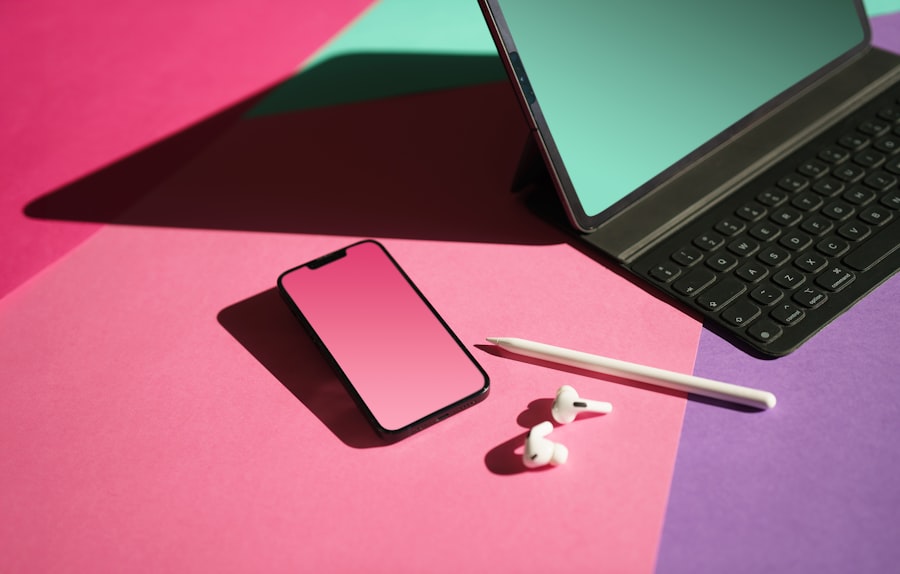Posture correction has emerged as a significant area of focus in health and wellness, particularly in an age where sedentary lifestyles are prevalent. The way we hold our bodies while sitting, standing, or moving can have profound implications for our overall health. Poor posture is not merely an aesthetic concern; it can lead to a myriad of physical ailments, including chronic pain, reduced mobility, and even psychological effects such as decreased confidence.
As awareness of these issues grows, so does the interest in effective methods for improving posture. Among these methods, wearable technology has gained traction as a practical solution for individuals seeking to enhance their posture and overall well-being. Wearable devices designed for posture correction are becoming increasingly sophisticated, leveraging advancements in technology to provide real-time feedback and personalized guidance.
These devices can range from simple straps that remind users to sit up straight to more complex systems that analyze body mechanics and provide detailed insights. The integration of technology into posture correction not only makes it more accessible but also allows for a tailored approach that can adapt to individual needs. As we delve deeper into the impact of poor posture on health and the role of wearables in addressing these issues, it becomes clear that this intersection of technology and health is paving the way for innovative solutions.
Key Takeaways
- Poor posture can have a significant impact on overall health, leading to issues such as back pain, reduced lung capacity, and decreased mobility.
- Wearables, such as posture correctors and smart clothing, play a crucial role in helping individuals improve their posture and prevent long-term health problems.
- There are various types of wearables available for posture correction, including posture trainers, smart shirts, and posture-correcting bras.
- Wearables use sensors and advanced technology to track and monitor posture, providing real-time feedback and encouraging users to maintain proper alignment.
- Using wearables for posture correction can lead to benefits such as improved posture, reduced pain, and increased awareness of body positioning, ultimately contributing to better overall health and well-being.
The Impact of Poor Posture on Health
The Physical Consequences of Poor Posture
Poor posture can have far-reaching consequences that extend beyond mere discomfort. One of the most immediate effects is musculoskeletal pain, particularly in the neck, shoulders, and lower back. For instance, individuals who spend long hours hunched over a computer may experience tension headaches and chronic pain due to muscle strain. Over time, these issues can lead to more severe conditions such as herniated discs or degenerative joint disease.
The Impact on Mobility and Flexibility
The physical toll of poor posture is compounded by the fact that it can also hinder mobility and flexibility, making everyday activities more challenging. This can significantly affect various aspects of health, from performing daily tasks to engaging in physical activities.
The Psychological Effects of Poor Posture
Research has shown that posture can influence mood and cognitive function. For example, slouched or closed-off body positions are often associated with feelings of depression and anxiety, while open and upright postures can enhance feelings of confidence and positivity. This psychological aspect is particularly relevant in professional settings where posture can impact not only personal well-being but also workplace dynamics and productivity.
The interplay between physical and mental health underscores the importance of addressing posture as a holistic concern rather than a mere cosmetic issue.
The Role of Wearables in Posture Correction

Wearable technology has revolutionized the way individuals approach health and fitness, and posture correction is no exception. These devices serve as constant companions, providing users with real-time feedback on their posture throughout the day. By utilizing sensors and algorithms, wearables can detect deviations from optimal posture and alert users when they need to make adjustments.
This immediate feedback loop is crucial for developing awareness and fostering better habits over time. In addition to real-time alerts, many wearables offer features that promote long-term improvement. For instance, some devices track posture trends over days or weeks, allowing users to visualize their progress and identify patterns in their behavior.
This data-driven approach not only motivates individuals to stay committed to their posture correction journey but also provides valuable insights that can inform lifestyle changes. As wearables continue to evolve, their role in posture correction is likely to expand, incorporating more advanced technologies such as artificial intelligence and machine learning to provide even more personalized recommendations.
Types of Wearables for Posture Correction
The market for posture correction wearables is diverse, offering a range of options tailored to different preferences and needs. One common type is the posture-correcting strap or brace, which is designed to be worn around the shoulders or back. These devices gently pull the shoulders back and align the spine, serving as a physical reminder to maintain proper posture.
Some models are adjustable and can be worn discreetly under clothing, making them suitable for both work and leisure activities. Another category includes smart shirts or tops embedded with sensors that monitor body alignment. These garments provide a seamless way to track posture without the need for additional accessories.
They often connect to mobile applications that offer insights into posture habits and suggest exercises or stretches to improve alignment. Additionally, there are wearable devices that resemble fitness trackers but are specifically designed for posture monitoring. These devices typically feature vibration alerts that activate when the user slouches or adopts an incorrect position, providing immediate feedback without being overly intrusive.
How Wearables Track and Monitor Posture
Wearable devices utilize a combination of sensors—such as accelerometers, gyroscopes, and magnetometers—to track body position and movement accurately. Accelerometers measure changes in velocity and orientation, allowing the device to detect shifts in posture in real time. Gyroscopes complement this by providing information about rotational movement, which is essential for understanding how the body aligns itself in three-dimensional space.
Once the data is collected, sophisticated algorithms analyze it to determine whether the user is maintaining proper posture. Many devices employ machine learning techniques to improve their accuracy over time by learning from user behavior patterns. For instance, if a user consistently slouches while working at a desk, the device can adapt its feedback mechanisms to provide more targeted reminders during those specific times.
This level of personalization enhances the effectiveness of wearables in promoting better posture habits.
Benefits of Using Wearables for Posture Correction

Increased Posture Awareness
The advantages of using wearables for posture correction are numerous. One of the most significant benefits is the increased awareness they foster regarding one’s posture throughout daily activities. Many individuals are unaware of their poor postural habits until they experience discomfort or pain; wearables bridge this gap by providing continuous feedback that encourages mindfulness about body alignment.
Enhancing Motivation through Gamification
Wearables can also enhance motivation through gamification elements integrated into their applications. Users may earn rewards or badges for achieving specific posture goals or maintaining good alignment over time. This element of fun can make the process of improving posture more engaging and less daunting.
Tracking Progress and Reinforcing Positive Behavior
Furthermore, by tracking progress over time, wearables help users visualize their improvements, reinforcing positive behavior changes. This feature allows individuals to see the impact of their efforts, making it more likely for them to continue practicing good posture.
Tips for Using Wearables Effectively for Posture Correction
To maximize the benefits of wearable technology for posture correction, users should consider several strategies. First and foremost, consistency is key; wearing the device regularly will yield the best results. Users should aim to incorporate their wearables into their daily routines—whether at work, during exercise, or while relaxing at home—to develop a comprehensive understanding of their postural habits.
Another important tip is to engage with the accompanying mobile application actively. Many wearables offer educational resources on proper posture techniques and exercises designed to strengthen postural muscles. By taking advantage of these resources, users can complement their wearable’s feedback with actionable steps toward improvement.
Additionally, setting realistic goals can help maintain motivation; rather than aiming for perfection immediately, users should focus on gradual progress over time.
Conclusion and Future of Wearables in Posture Correction
As we look ahead, the future of wearables in posture correction appears promising. With ongoing advancements in technology, we can expect even more sophisticated devices that offer enhanced tracking capabilities and personalized feedback mechanisms. The integration of artificial intelligence may lead to wearables that not only monitor posture but also predict potential issues based on user behavior patterns.
Moreover, as awareness about the importance of good posture continues to grow across various demographics—from office workers to athletes—wearable technology will likely become an essential tool in promoting overall health and well-being. The potential for collaboration between healthcare professionals and wearable manufacturers could further enhance the effectiveness of these devices by incorporating clinical insights into design and functionality. Ultimately, as society embraces a more proactive approach to health management, wearables will play a pivotal role in shaping how individuals address their postural health challenges.
If you’re interested in how technology can enhance personal health and wellness, particularly in the realm of posture correction through wearables, you might also find value in exploring other technological advancements. For instance, understanding the capabilities of the latest smartphones can provide insights into how these devices incorporate health-tracking features. A relevant article that delves into this topic is about the Samsung S22 Ultra, which discusses its advanced features that could potentially support health applications, including posture tracking. You can read more about it here.
FAQs
What are wearables?
Wearables are electronic devices that can be worn on the body as accessories or implants. They are designed to perform a specific function and are often used for tracking health and fitness data.
How can wearables help with posture correction?
Wearables can help with posture correction by providing real-time feedback on body positioning and movement. They can alert the wearer when they are slouching or not maintaining proper posture, helping to improve overall posture over time.
What types of wearables are available for posture correction?
There are various types of wearables available for posture correction, including posture-correcting shirts, posture-correcting straps, and posture-correcting devices that can be worn on the back or shoulders. These devices use sensors and technology to monitor and correct posture.
Are wearables effective for posture correction?
Wearables can be effective for posture correction when used consistently and in conjunction with other posture-improving strategies, such as exercise and ergonomic adjustments. However, individual results may vary.
Are there any potential drawbacks to using wearables for posture correction?
Some potential drawbacks of using wearables for posture correction include discomfort from wearing the device, reliance on technology for posture correction, and the need for regular charging or maintenance of the wearable device. It’s important to consider these factors before using wearables for posture correction.

